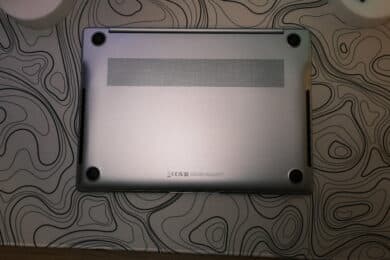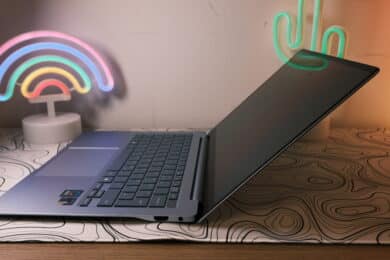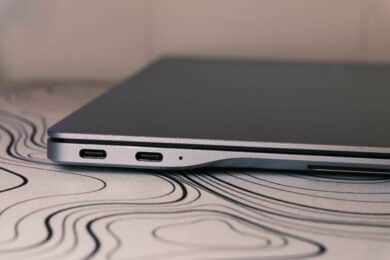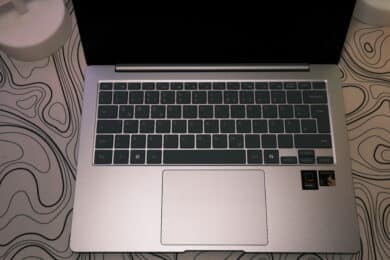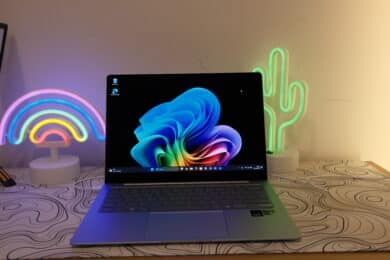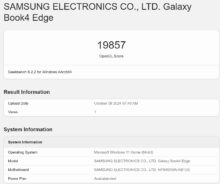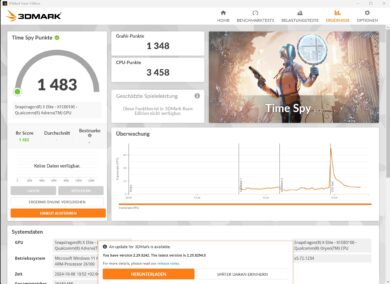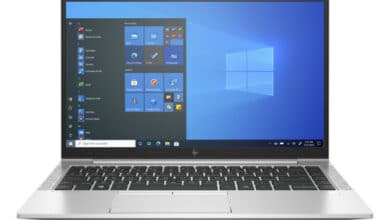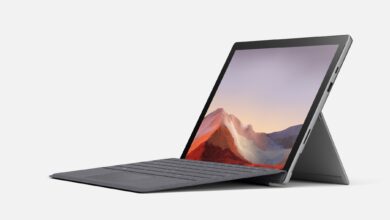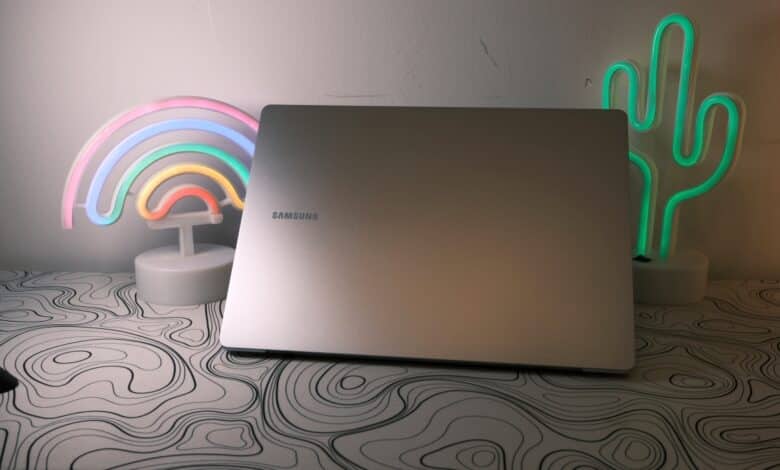
Windows on ARM is currently a hot topic, as the Snapdragon X processors from Qualcomm score particularly well in terms of energy efficiency, while the top models around the Snapdragon X Elite also want to impress with their performance. The new Samsung Galaxy Book4 Edge is the counterpart to the Galaxy Book4 Pro, which we have already reviewed in the form of the Book4 Pro 360 convertible laptop. But how does the Snapdragon X Elite variant fare? Our test reveals more.
Technical data
| The product | Book4 Edge |
| Processor | Qualcomm Snapdragon X Elite X1E-80-100 (12 x 4.0 GHz) |
| Graphics performance | Qualcomm SD X Adreno X1-85 |
| Display | 14 inch; AMOLED; 2,880 x 1,800 pixels; 120 Hz (dynamic); touchscreen |
| Storage space | 512 GB eUFS memory |
| Working memory | 16 GB LPDDR5x RAM (2x 8 GB; soldered) |
| Keyboard | Chiclet full size; with white illumination |
| Operating system | Windows 11 Home |
| Connectivity | Wi-Fi 7; Bluetooth 5.3 |
| Dimensions (W x D x H) | 312.3 mm x 223.8 mm x 10.9 mm |
| Weight | 1,162 g (without power adapter) |
| Price | € 1,498.00 * |
Samsung Galaxy Book4 Edge review: Noble and familiar design
- Elegant and unobtrusive design; excellent workmanship
- Pleasantly light and compact
- System and RAM not replaceable
The 14-inch version of the Samsung Galaxy Book4 Edge looks very familiar to us. No wonder, as the notebook has the same elegant design that already characterized the Book4 Pro and Book4 Ultra (our test).
The first thing that stands out is the extremely low weight, as the laptop weighs just 1.16 kilograms. The 14-inch laptop is also extremely handy at just 31.2 cm x 22.4 cm x 1.09 m, making it an interesting choice for mobile use. Lightweight and compact, that’s how a notebook should be in my eyes.
The Samsung notebook also cuts an excellent figure visually and looks great with its Sapphire Blue color scheme and anodized design. The Samsung lettering is emblazoned on the display lid, only in very small letters, otherwise the device is kept pleasantly clean.
When opened, only the Snapdragon X Elite sticker reveals that we are dealing with the ARM model. The build quality of the Samsung Galaxy Book4 Edge is also excellent, while the stability around the hinges and display lid leaves nothing to be desired.
Opening the notebook also reveals one of the biggest differences to the Intel model, as Samsung uses eUFS storage instead of one (or more) M.2 2280 SSDs in the Book4 Edge. This means that the system memory is not interchangeable, just like the RAM.
Features and connections
Instead of Intel’s Meteor Lake as in the Book4 Pro, the Samsung Galaxy Book4 Edge relies on Qualcomm’s Snapdragon X Elite processors. Specifically, the Snapdragon X Elite X1E-80-100 is the second-fastest chip in the series, combining 12 cores with a clock speed of 4.0 GHz.
It is supported by the fast Qualcomm SD X Adreno X1-85 GPU with 3.8 TFLOPS performance and the NPU with 45 TOPS. In addition, there is 16 GB of LPDDR5X RAM and 512 GB of system memory – not expandable, as mentioned.
In terms of connectivity, the Book4 Edge is even better and relies on fast Wi-Fi 7 with excellent transfer speeds. There is also Bluetooth 5.3 for connecting wireless accessories.
Samsung has also equipped the laptop with four very good-sounding speakers, which are pleasantly loud thanks to the Smart Amp, deliver clear sound and support Dolby Atmos. The webcam with a resolution of 2 megapixels offers a usable image quality, but not much more.
Samsung Galaxy Book4 Edge with USB4
Of course, the extremely flat casing also has a disadvantage in terms of connectivity. You have to do without USB-A ports on the Samsung Galaxy Book4 Edge. Instead, there are two USB 4 Type-C ports on the left-hand side.
Both with DisplayPort Alt mode and PowerDelivery, whereby one of the ports is occupied when the laptop is powered or charging. There is also an HDMI 2.1 port on the right-hand side, as well as a 3.5 mm jack for connecting headphones or headsets. Unfortunately, that’s all there is.
Neat controls, strong AMOLED display
The Samsung Galaxy Book4 Edge has inherited the keyboard from the Book4 Pro and Ultra, which Samsung itself calls the Pro Keyboard. Well: I wouldn’t call it pro, because the key travel of the chiclet keyboard is very low, which doesn’t necessarily make it comfortable for writing longer texts.
The keyboard is good for occasional typing, but I wouldn’t want to type really long texts on it. Fortunately, the 14-inch version does away with the numeric keypad and therefore offers larger keys.
In theory, the keyboard also has a white backlight that should activate when you hit the keys. However, apart from the brightness adjustment on the keyboard, this could not be activated on our test model.
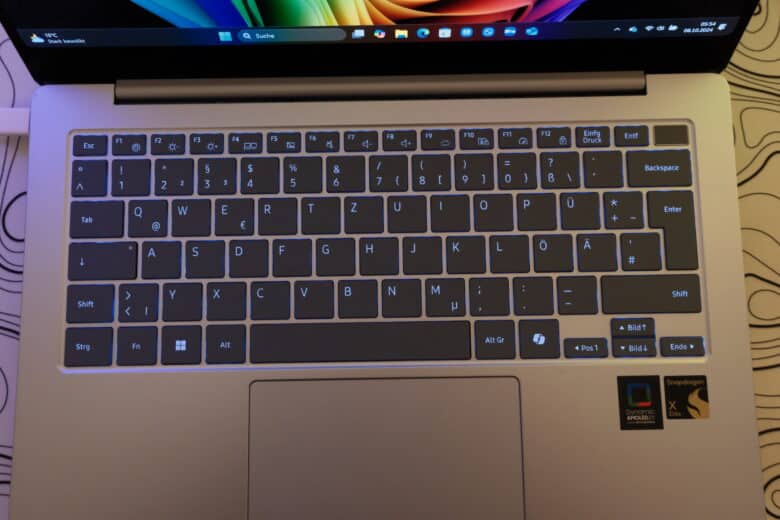
There is also an 8.2 cm x 11.2 cm ClickPad, which is installed in the center and scores with excellent gliding properties. It implements gestures pleasantly accurately and gives no cause for criticism.
The same applies to the appealing AMOLED display, which has a pleasantly high resolution of 2,880 x 1,800 pixels on 14 inches and a refresh rate of 120 Hz, which ensures a smooth display.
As is typical for OLEDs, the display scores with excellent contrasts and great color reproduction. The screen is also bright at around 550 nits to ensure excellent readability even in direct sunlight.
Samsung Galaxy Book4 Edge in a practical test
The Snapdragon X Elite in the Samsung Galaxy Book4 Edge relies on the ARM structure and also has an AI computing unit that is fast enough to use Microsoft’s AI assistant Copilot+.
What sounds ultra exciting on paper is not much more than a nice extra. Voice recordings can be transcribed, texts summarized or images generated with the help of artificial intelligence. However, none of this is anything that other AI chatbots online couldn’t do, and in some cases with noticeably better quality.

As for the ARM platform itself, it requires specially adapted software to get the maximum performance out of it. Fortunately, most everyday programs such as MS Office or Adobe apps have already been adapted, with more following almost daily.
However, there are also exceptions, as incompatibilities with drivers or programs can occur under the ARM architecture. Time and again we read about printers whose drivers cannot be installed or apps that cannot be started.
During my test, however, I had no problems getting any software or devices that I use regularly to run. Especially as classic x86 Windows programs can of course also be used on the Book4 Edge – but then in an emulated version and with more or less noticeable performance losses. But here, too, you will usually hardly notice in everyday use whether a program is running natively or has been emulated.
The nice thing about the Samsung Galaxy Book4 Edge is its pleasantly quiet operation. Even under constant load, the fans hardly turn up noticeably in the standard profile and remain pleasantly quiet at a measured 28 dB(A). If you like it even quieter, you can also select a corresponding profile and then only reach 26 dB(A), albeit with reduced performance. The surface of the notebook also remains quite cool, with only the area below the display heating up to around 50 degrees Celsius under load.
Benchmark: Productivity, system, SSD and gaming
Of course, the performance of the Samsung Galaxy Book4 Edge is interesting, especially in direct comparison to the Book4 Pro with Intel Meteor Lake. Let’s start with the eUFS mass storage, which is pleasingly fast.
The speeds are almost identical to the PCIe 4.0 x-4 SSD used in the Intel model. With around 3,164 MB/s read and 2,617 MB/s write, the storage delivers good, everyday performance. However, its 4K and 4K-64Thrd performance is somewhat weak, which is particularly important for graphics-intensive applications and games. However, this is not the Snapdragon X processors’ specialty anyway, as we will see later.
The Snapdragon X Elite shows its strengths above all in single-core performance, where it can outperform the Core Ultra 7 155H. So… at least in Cinebench 2024, which runs natively on the ARM architecture. Geekbench 6 also shows a similar result, with the Samsung Galaxy Book4 Edge coming out on top in both single-core and multi-core performance.
In Cinebench R23 and other tests that have to be emulated, things look different. Here, there is a clear drop in performance compared to x86, on which the apps run natively. The Snapdragon X Elite is more than 50 percent behind the Core Ultra 7, especially in the multi-core test of Cinebench R23.
| Benchmark | Result |
| Cinebench R23 Multi Core | 5,541 pts. |
| Cinebench R23 Single Core | 1,112 pts. |
| Cinebench 2024 Multi Core | 551 pts. |
| Cinebench 2024 Single Core | 105 pts. |
| PCMark 10 Applications | 13,124 pts. |
| CPU-Z Single Core | 682.3 pts. |
| CPU-Z Multi-Core | 8,124.7 pts. |
| Geekbench 6 Multi Core | 13,639 pts. |
| Geekbench 6 Single Core | 2,625 pts. |
| Geekbench 6 GPU | 19,857 pts. |
The Adreno X1-85 iGPU of the Qualcomm Snapdragon X Elite X1E-80-100 is noticeably faster than that of the Snapdragon X Plus models, but that doesn’t mean you should expect miracles here. The gaming performance is below average overall and achieves around 50 percent of the performance that the Intel Arc iGPU is capable of. The Galaxy Book4 Edge is therefore not really suitable for gaming, but the performance remains constant even on battery power.
Battery life of the Samsung Galaxy Book4 Edge
- 55-9 watt-hour battery
- Compact USB-C charger
- (Disappointing) 9 hours of battery life
Snapdragon X Elite battery monster? Well, unfortunately this does not apply to the Galaxy Book4 Edge, as the runtimes of the compact 14-incher are rather disappointing – despite the 55.9 Wh battery. The PCMark 10 battery benchmark only lasted around 9 hours before it shut down the laptop (without finalizing the result).
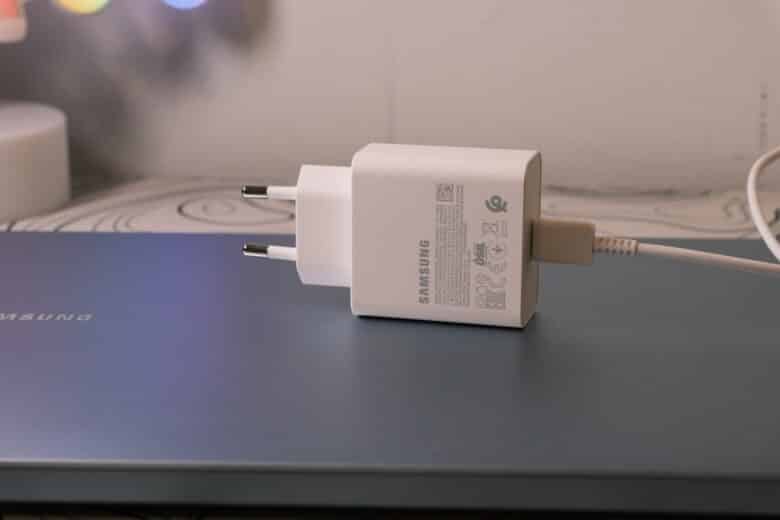
.
Here, most Snapdragon X laptops, but also some of the more efficient Intel and AMD laptops, sometimes deliver noticeably better runtimes. The Dell Inspiron 14 Plus (our test) lasts noticeably longer with a runtime of around 15 hours. Even the Book4 Pro 360 with Intel chip (but noticeably larger battery) is significantly more efficient with a runtime of almost 12 hours.
Samsung Galaxy Book4 Edge Review: Conclusion
Thanks to its bright and colorful OLED display, excellent workmanship and powerful SnapdragonX Elite chip, the Samsung Galaxy Book4 Edge is undoubtedly one of the best notebooks on the still young Windows on ARM platform with Qualcomm processors.
The laptop also scores with modern standards such as Wi-Fi 7 and two USB4 ports. This makes it easy to get over the fact that there was no more space for USB-A in the handy and lightweight casing. The Galaxy Book4 Edge also remains pleasantly quiet and comparatively cool under load.
However, the non-upgradeable UFS memory and the average battery life are a sour note. Although the laptop still lasts a good working day, other models with Qualcomm chips, as well as Intel and AMD laptops, deliver significantly longer runtimes.
Nevertheless, the Samsung Galaxy Book4 Edge is an excellent option and one of the best devices if you are looking for a Snapdragon X laptop and an interesting alternative, especially for the now significantly reduced price.
Samsung Galaxy Book4 Edge
Design & Workmanship
Display
Features
Performance
Battery
Value For Money
88/100
Elegant and lightweight notebook with a great OLED display, modern standards and a high-performance Snapdragon X Elite chip. However, the permanently soldered system memory and the average battery life are cause for criticism.

